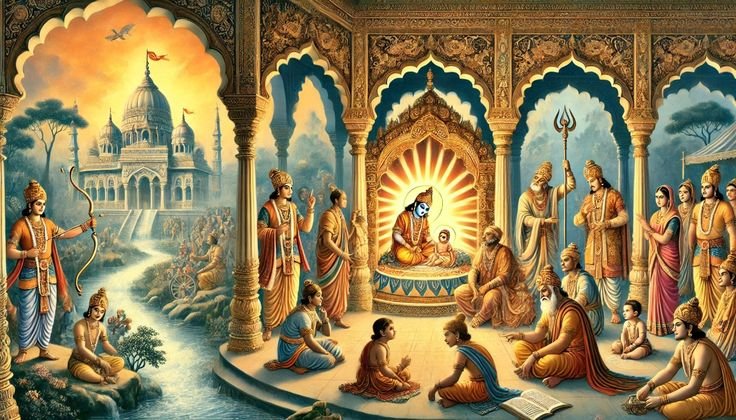Ramayan
Ithihas of Ramayan

The Ramayana is one of the most revered and ancient epics of India, composed by the sage Valmiki, who is honored as the Adi Kavi or the first poet. It is considered not merely a story, but an Ithihas — a divine chronicle of truth and history that portrays the eternal values of dharma (righteousness), satya (truth), and bhakti (devotion). The epic was composed thousands of years ago during the Treta Yuga and is written in classical Sanskrit, consisting of nearly 24,000 verses divided into seven sections known as Kandas. It narrates the life, virtues, and struggles of Lord Rama, the seventh incarnation of Lord Vishnu, who descended upon the earth to destroy evil and uphold righteousness.
The story begins in the ancient kingdom of Ayodhya, ruled by the wise and noble King Dasharatha. He had four sons — Rama, Bharata, Lakshmana, and Shatrughna — born through a divine blessing. Among them, Rama was the embodiment of truth, virtue, and compassion, beloved by all. On the day of his coronation, destiny took a turn when Queen Kaikeyi demanded that Rama be exiled for fourteen years and her son Bharata be crowned king. Without hesitation, Rama accepted the exile to honor his father’s word. Accompanied by his devoted wife Sita and loyal brother Lakshmana, Rama set forth into the forests, leaving behind the luxuries of palace life to follow the path of duty and sacrifice.
During their exile, the trio encountered sages, demons, and divine beings. It was in the forest that the great tragedy occurred — the abduction of Sita by Ravana, the powerful demon king of Lanka. This event became the turning point of the epic. In his quest to rescue Sita, Rama formed an alliance with the Vanara (monkey) king Sugriva and met the devoted Hanuman, whose unwavering loyalty and faith became legendary. Hanuman’s leap across the ocean to Lanka, his burning of the city, and his discovery of Sita in Ashok Vatika are among the most cherished episodes of the Ramayana.
The epic reaches its climax with the great war between Rama’s army and Ravana’s forces. With divine strength, strategic wisdom, and the help of his companions, Rama defeats Ravana, symbolizing the eternal victory of good over evil. After rescuing Sita and completing his exile, Rama returns to Ayodhya, where his coronation is celebrated with immense joy and devotion. This grand homecoming is remembered every year as Diwali, the festival of lights, marking the triumph of righteousness and the dispelling of darkness.
The Ramayana is not just a tale of adventure or war — it is a spiritual guide that reflects the deepest truths of human life. Each character in the epic embodies a profound moral lesson: Rama represents ideal virtue and duty, Sita stands for purity and steadfastness, Lakshmana exemplifies loyalty, Bharata signifies selfless love, and Hanuman is the eternal symbol of devotion and strength. Even Ravana, despite being the antagonist, represents the downfall caused by pride and ego, reminding humanity of the dangers of arrogance.
Over millennia, the Ramayana has transcended time and geography. Its message of love, faith, and righteousness continues to inspire countless generations. Variations of the story exist across Asia — in Thailand’s Ramakein, Cambodia’s Reamker, Indonesia’s Kakawin Ramayana, and many more. Its influence on Indian art, literature, dance, drama, and philosophy is immeasurable. The recitations of the Ramcharitmanas by Tulsidas in the Bhakti era further brought the story closer to the hearts of the common people, making it a living scripture rather than just a historical text.
Thus, the Ramayana stands as a timeless reflection of divine truth and human ideals. It teaches that even in moments of great trial, righteousness and devotion must never be forsaken. It is an eternal source of inspiration that reminds us that no matter how dark the path may seem, the light of truth and dharma will always lead to victory.





















































